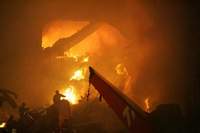Brazil's busiest airport likely to be closed after recent plane crash
Officials struggled Thursday to determine why a jetliner raced down a runway before crashing in a fireball that killed 189 people - an accident that set off a fierce debate over whether to suddenly close Brazil's busiest airport.

Security video released by the air force showed TAM Flight 3054 from Porto Alegre speeding down the tarmac more than four times as fast as other planes landing around the same time.
The Airbus-320 skidded off the main runway in a heavy rain, leaped over a highway and slammed into a building Tuesday night, killing all 186 people aboard and at least three people on the ground.
It was Brazil's worst air disaster and the worst anywhere involving an Airbus A-320, according to the aviation analysis Web site airsafe.com.
Brig. Jose Carlos Pereira, president of the national airport authority Infraero, said Thursday he was perplexed by the video.
"An airplane doesn't speed up by a miracle. Something happened after it touched down," Pereira said. "He landed normally, the images show that was the case."
Brazilian aviation consultant Elias Gedeon said it was too early to blame the pilot: "The bottom line is we don't know what happened. Why was he going so fast? He couldn't stop. Was it the water on the runway? Was it his ability? We don't know."
Congonhas recently resurfaced its runway to provide better braking in rainy conditions. But the new surface hadn't dried enough for the next step: cutting deep grooves into the tarmac that allow water to run off the runway and provide increased grip.
Federal prosecutors asked a federal judge to "temporarily paralyze" Congonhas Airport - a move that could disrupt air travel across Latin America's largest nation - "until a complete renovation of both of its runways can be completed and there is certainty that they are fully secure for full operation."
Just six kilometers (four miles) from the center of Latin America's largest city, Congonhas offers convenience for domestic passengers, despite concerns about its proximity to densely populated areas and the safety of short runways that end just before a major highway.
"This airport is too convenient not to be used," said Vivianne Santorini, a 57-year-old attorney waiting to check in for a flight to the central city of Belo Horizonte. "Is it safe? I guess not. But there are also risks driving you car and crossing the street and everybody continues driving their car and crossing the street."
Leonardo Mota Netto, chief spokesman for Infraero, said closing the airport was not realistic.
"To close down Congonhas, to do it correctly, would take at least 15 years," Mota said. "That is the time needed to build viable alternatives, new airports, and redirect flights to other airports in the region which will also have to undergo improvements in their infrastructure."
Mota said that about18 million people pass through Congonhas each year. The airport, built in 1936 on what were then the city's outskirts, is designed to handle 12 million.
He said airlines and the public have resisted moves to limit flights at Congonhas and Brazil needs more airports, not fewer, with the number of air passengers growing at a rate of around 16 percent a year.
The alternatives, at least in the short run, appear to be few.
Sao Paulo's international airport in Guarulhos lies 36 kilometers (22 miles) from the city center through dense traffic-clogged streets and doesn't have enough capacity to add all the flights that pass through Congonhas.
Aviation officials insist that Congonhas' 6,362-foot (1,939-meter) runway is safe, but pilots have complained about slippery conditions when wet and the small margin of error.
In 1996, a TAM Airlines Fokker-100 crashed into nearby houses shortly after takeoff, killing all 96 aboard and six on the ground.
On Thursday, another TAM plane had to pull out of a landing and was rerouted to the city's international airport after coming in at an unsafe angle - a fairly routine event at Congonhas.
A day before the crash, two planes skidded off the runway. And on March 22, a Boeing 737-400 overshot it in a heavy rain, stopping just short of a steep drop.
In February, a federal court briefly banned three types of large jets from the runway, but was overruled on appeal. Airbus-320s were not covered under the court's ban.
By Thursday, 181 bodies had been retrieved from the site where the Airbus crashed, but forensic examiners had managed to identify only 11 and said it could take a month to identify them all.
The crash came less than a year after Brazil's previous worst air disaster: 154 people were killed in the September collision of a Gol Airlines Boeing 737 with a small jet over the Amazon rainforest.
That accident touched off months of congressional investigations that raised questions about the country's underfunded air traffic control system, deficient radar and lack of investment in infrastructure, even as airlines struggle to cope with a surge in air travel caused by Brazil's booming economy.
Finance Minister Guido Mantega said the government has invested heavily in Brazil's air travel infrastructure and plans future investments of 1 billion reals (US$526 million; Ђ382 million) to meet rising traffic.
The plane's two black boxes were being sent to the United States for analysis and French investigators also were helping probe the cause of the crash.
Henrique Castro de Souza, a civil servant in line for a TAM flight Thursday, said he believed the airport should close.
"Whenever lives are at risk and something can be done to reduce that risk, if that means shutting down this airport so be it," he said. "Of course, it's going to create a mess, but you have to choose between messes and life."
Subscribe to Pravda.Ru Telegram channel, Facebook, RSS!

